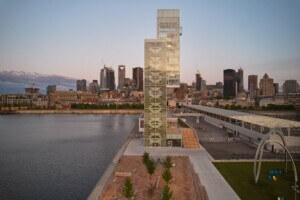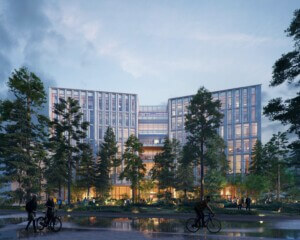Facades+ Dallas will be The Architect’s Newspaper’s first in-person event of 2021. Ahead of the full-day conference, AN sat down with co-chair Mark Holsinger, director of design at Omniplan, to gain insight into the local trends that will be discussed with the A-list speakers in the lineup. The event will highlight projects, such as the unique fabrication of the AC Hotel and bespoke residential work of Kinneymorrow, that have yet to be presented to the public. This unparalleled opportunity for attendees will also give speakers from abroad, such as Matthew Lella from the Toronto-based Diamond Schmitt, the opportunity to see their own work for the first time since borders have opened post-pandemic. Striving to include a breadth of facade design topics, the program will feature a morning of panel dialogue and presentations followed by an afternoon of manufacturer-led workshops.
AN: What facade trends have you noticed in the northwest region of Texas and beyond?
Mark Holsinger: For [Omniplan], energy-efficient materials and anything we can do to reduce building costs or extend the lifecycle, so looking at just any kind of material that’s going to help in that direction. We really like natural materials, things that have a story and can age, or even if they can help tell a story we’re interested in. So being very authentic, we’re attuned to things that have texture and warmth. That kind of adds a layer of authenticity to a project. Anything in Texas is subject to kind of a harsh climate[…] anything that material-wise that we can incorporate, that will help again with heat gain, solar gain, and [climate-driven] things that designers are looking at.
What do you think the Facades+ audience can gain from being in person after a full year of virtual events?
I think anything that is in person is always more dynamic and more interesting and more of a collaboration of ideas. Architecture is a very collaborative process. Given that we’re back at the office, I think that’s helped with our design and process. The community of Dallas architects—or rather Texas architects—being able to come together, exchange ideas, and listen to speakers that are working on specific building types and are interested in different ideas is always better for the industry as a whole, and design as a whole. Pushing the places we’re creating, that we’re living in, to improve.
What are you most excited about hearing?
To tell you the truth, I think that all the panels are talking about projects that I’ve admired from afar, would like to learn more about, and would like to hear from the person that actually worked on them. So as I said, you know, I’m particularly interested in projects that are community-based and can enhance the lives of the community and bring people together. [It’s exciting] to see peers talk about the AC hotel, which I admire as a new building in Dallas and think is a high level of design. On the residential side, and I don’t work in residential, Kinnyemorrow is a firm that I’ve admired their work with adaptive reuse, and how they’ve done that is kind of stunning to me and really beautiful. So I’m excited to hear them speak.
Why do you think Facades+ is so critical to the AEC community?
I think I think facades are hugely important in how they communicate a project and how we interact with the built environment. I find in our office, really harping just scale and proportion, how a project is detailed, and kind of finding that balance between very rich textured materials (as opposed to more sleek materials) and how your material selection can read in and create an interesting kind of composition[…] and also relate a message about what the building is about is very important. So I think—you know, you hear the words “facade conference”, [and think] what does that even mean? When you start to think about all that, it’s kind of the outward expression of the building. So how are different architects and designers doing that? How are their enclosures responding to the climate? And what ideas do you grasp from other people’s work?











